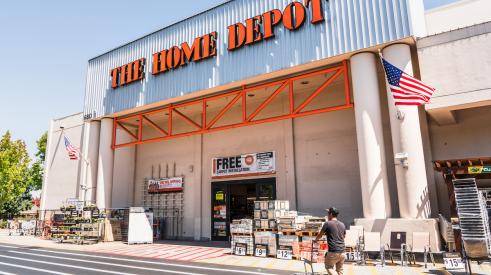When the stimulus package was announced earlier this year, the energy efficient tax credits caused some confusion. Here are common questions the editors of Professional Remodeler have fielded and the answers.
1. What types of projects are eligible for the tax credit?
The new tax credits cover a wide variety of energy-efficient aspects of remodels: windows and doors; insulation; geothermal features; solar panels; water heaters; wind energy systems; roofs; HVAC; fuel cells; and biomass stoves. Energy Star-rated appliances that don’t fall into any of those categories, such as dishwashers and refrigerators, are not eligible.
2. How large are the tax credits?
The credit is 30 percent of the cost — up to $1,500 — for most products. However, for geothermal systems, solar panels, solar-powered water heaters and wind energy systems, the credit is 30 percent with no cap. Fuel cells are capped at $500 per .5 kW of power capacity, but there is no limit on the total credit.
3. How long do the credits last?
The credits for most projects (those capped at $1,500) are only available in 2009 and 2010, but the credits for the products with no lifetime caps (those categories listed in question 2) last until 2016.
4. Are products that were installed before the stimulus package passed eligible for credits?
Yes, as long as they were put into service this year. Any product that met the tax credit standards in place at the time is eligible for the full credit. Be sure to contact any clients you worked for before the stimulus passed to make sure they’re aware of their new windfall.
5. Are installation costs included in figuring the tax credit?
That depends. For most products, installation costs are included to calculate the 30 percent credit, but they are not for windows, doors, insulation and roofs. For those categories, only the cost of materials is eligible for the credit. This means you’ll need to provide a material cost to your clients for those projects if they want to receive the credit.
6. How do I know which products qualify for the tax credits?
One of the most confusing thing about the credits is that not all products — not even all Energy Star products — qualify. There are minimum requirements in each product category. For example, windows must meet a higher standard of a U factor and a Solar Heat Gain Coefficient (SHGC) of less than .30. For a full list of product standards.
7. Can the credits be used for vacation homes, new construction or rental properties?
For most product categories, homeowners can only receive the credit for improvements to their primary residence. However, geothermal systems, wind energy systems, solar panels and solar water heaters are eligible when installed in a vacation home or in new construction projects. Fuel cells are eligible when installed in new construction, but only if the home is being built as a primary residence.
Almost all rental properties are not eligible for any credits. The only exception is a vacation home that the owner occupies for part of the year and rents for the rest of the year. In that case, the owner could take a pro-rated portion of the credits for the four product classes mentioned above.
8. Can homeowners receive the credits if the new products are installed in an addition?
Yes. While it initially seemed that additions would not be eligible for the credits because the products would not be an “improvement” to an existing building, the IRS recently confirmed that products used in an addition can be used to claim the full tax credit.
9. How many times can a homeowner take the credit?
For the products that are capped at $1,500 (windows, insulation, etc.), homeowners can get a credit on multiple projects, but they can only claim a total of $1,500 combined in 2009 and 2010. Two unmarried people living in the same household can each take the $1,500.
The products that are eligible for the 30 percent credit with no total cap (solar, geothermal, etc.) can be taken as many times as a homeowner installs eligible products through 2016.
10. What do remodelers need to provide clients so they get the credits?
You should give your clients a detailed receipt, along with what the IRS is calling a “Manufacturer’s Certification Statement.” This should include the name and address of the manufacturer; identification of the type of product; make, model and any other identifiers of the specific product used; and a statement that the product is eligible for the tax credit. The homeowners do not need to file the statement or receipt with their taxes but should have them for their records in case of an audit.
Useful Stimulus Information Links:
Energy Star
IRS Guidance on Stimulus Package Tax Credits
HousingZone Stimulus Hot Topic
Remodelers Exchange: Marketing the Stimulus
Related Stories
4 Steps to Prep Your Business for Contraction
How a remodeling company plans ahead for the worst of times (and the best of times)
Creating a Company Fire Drill: How to Prepare for the Worst
A disastrous fire could have been a lot worse if the business wasn’t prepared for the unexpected
The Fundamentals of Growing Profitably
On this episode of Women at WIRC podcast, Nip Tuck Remodeling Owner April Bettinger shares how she plans for her company's profitable growth
3 Things to Add to Your Construction Contract—From a Lawyer
Did you know you can add these three elements to your contracts?
Study Finds Remodelers’ Net Profits Declined
How far did net profits decline and what's influencing the drop?
The Home Depot Bets on Pros Amid Predictions of Flat Sales Growth
For the first time since 2019, The Home Depot’s revenue fell short of Wall Street’s predictions amid a general softening in the home improvement market
Indicators of a Softening Market and How to Prepare
Market conditions could be changing, but don't panic. Richardson shares ways to stay on top of market conditions and how to prepare for any potential softening down the road.
Grow Your Business Through Collaboration with Remodeling Peers
Remodeling Mastery Forums offers a unique business opportuniy for remodelers












